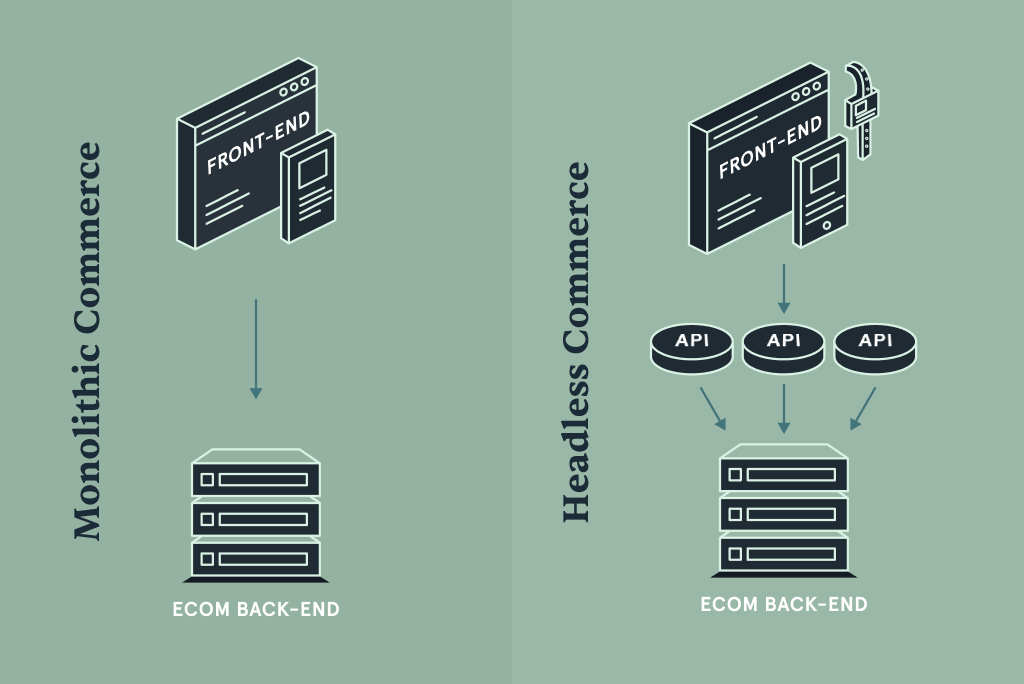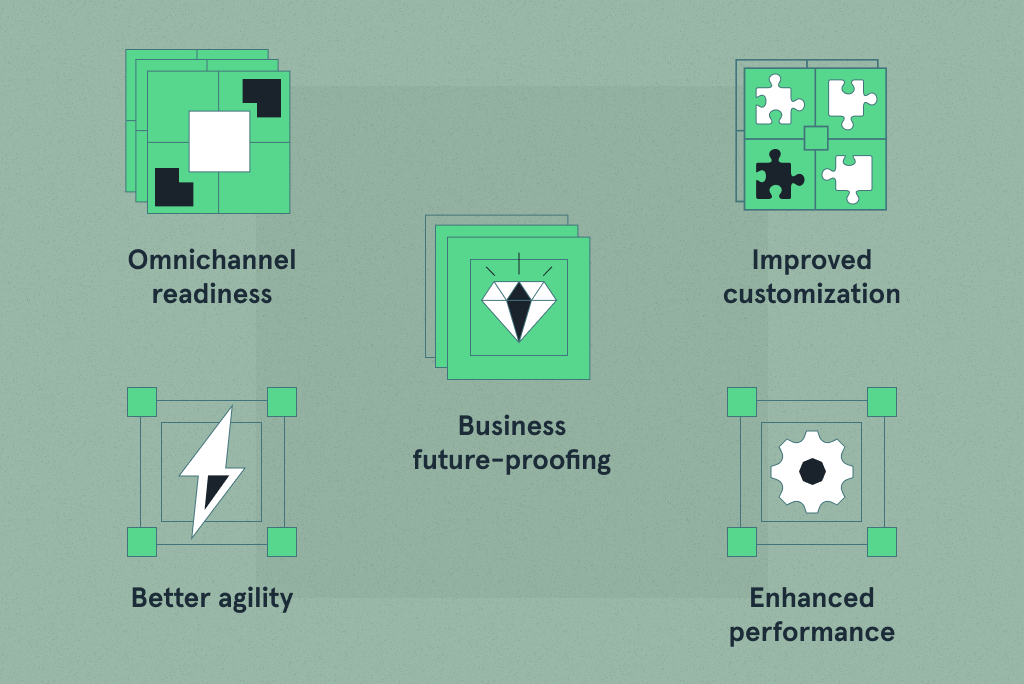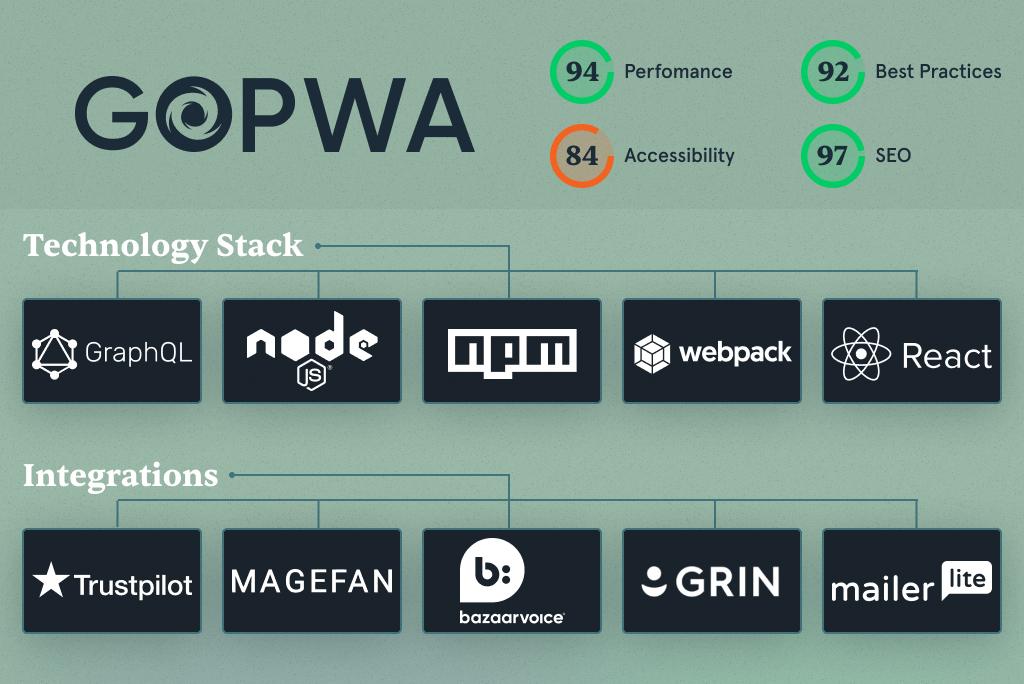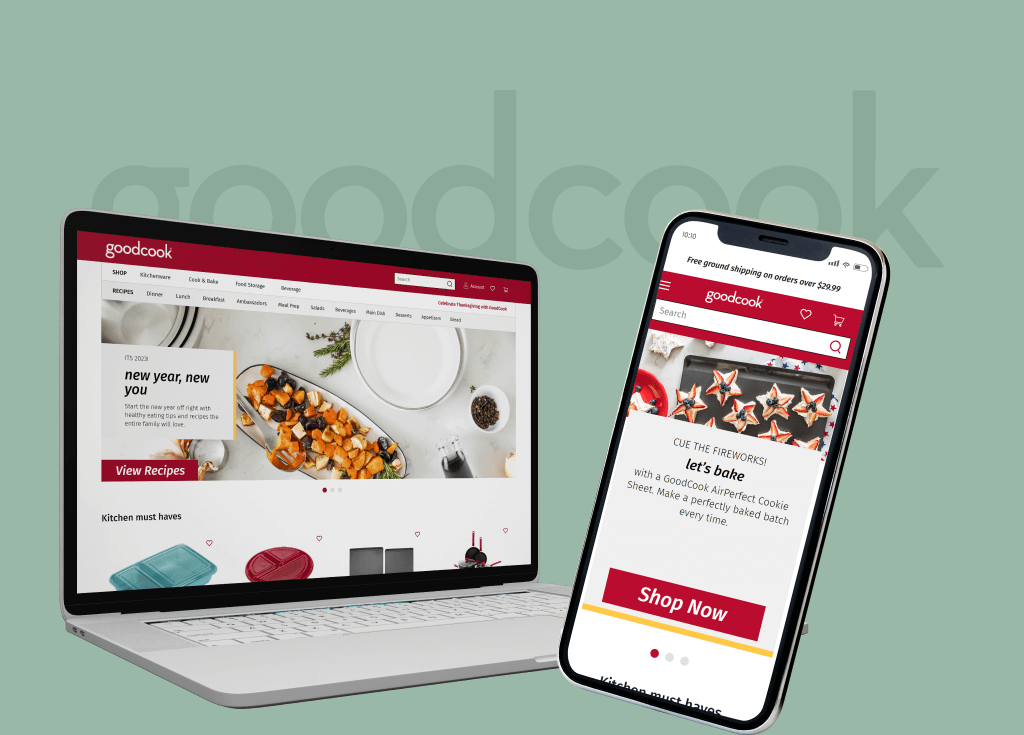The phrase "headless commerce" may evoke a sense of bewilderment. However, rest assured, there's nothing macabre about it. It's actually a groundbreaking trend in the eCommerce arena.
Imagine this: a flexible eCommerce model that enables bespoke customer experiences, accelerates your website speed, and pushes past the restrictions of traditional sales platforms. Intriguing, isn’t it? That’s the innovative appeal of headless headless commerce architecture!
In this all-encompassing guide, we’re going to dissect a headless solution in the B2B context. We’ll cover everything you need to know – its core principles, the sweeping advantages it brings to B2B businesses, and a step-by-step guide to successful headless commerce implementation. Moreover, we won’t shy away from its challenges, but instead, we’ll offer practical solutions to tackle them head-on.
So, are you prepared to delve into the fascinating world of headless commerce and see how it’s revolutionizing the B2B eCommerce landscape? Dive right in!
What is B2B Commerce?
Before we delve deeper into the realm of headless eCommerce, it’s essential to understand the foundation upon which it is built – B2B commerce itself.
Feel free to skip this part if you’re already familiar with it.
B2B Commerce, or Business-to-Business Commerce, involves transactions and interactions between businesses rather than between a business and individual consumers (B2C). This form of commerce typically takes place in a wholesale scenario where one business sells products or services in bulk to another business.
Unlike B2C commerce, B2B commerce involves more complex decision-making processes, longer sales cycles, and often, larger transaction volumes. The participants in B2B commerce are typically manufacturers, wholesalers, retailers, and service providers, all operating in a business ecosystem that prioritizes efficiency, long-term relationships, and bulk transactions.
As we move further into the digital age, B2B commerce has expanded beyond traditional boundaries. It’s no longer limited to face-to-face sales meetings or phone orders. Today, B2B eCommerce – the selling and purchasing of goods and services online – has become a significant part of the B2B commerce landscape. And that’s where the concept of B2B headless commerce starts to come into play.
In our next section, we’ll introduce headless commerce in general before we delve into the specifics of B2B Headless Commerce, its benefits, and how it’s revolutionizing the way businesses operate in the digital world.
What is Headless Commerce?
In the most straightforward terms, headless commerce is an eCommerce solution where the front-end presentation layer (‘the head’) is decoupled from the back-end functionality layer. This separation gives businesses unprecedented flexibility and agility in their eCommerce operations.
Think of a car. In a traditional commerce system, the car’s body (representing the back-end infrastructure) and the paint job or exterior design (representing the front-end customer experience) are inseparable. Changing the car’s color or design would typically mean a complete overhaul, affecting the structure of the car itself.
In a headless solution, however, the car’s body and paint job are entirely independent. You can alter the car’s exterior – change its color, add graphics, switch the wheels – all without touching the car’s engine, structure, or interior. You have complete freedom to customize the car’s appearance to suit your preferences, all while the crucial functioning parts continue to operate unhindered.
So in essence, headless commerce is like having a car where you can freely modify its exterior without worrying about disrupting its performance or internal workings. Unlike traditional eCommerce solutions, headless solutions grant a level of flexibility and customization that’s highly appealing in today’s rapidly evolving digital commerce landscape.
Headless architecture is beneficial when businesses want to customize their front-end eCommerce experiences without disrupting back-end processes. It’s like having a well-oiled machine running the operations, while you get creative with the storefront to engage customers and maximize conversions.
Now, imagine the power of headless commerce combined with the complexities and vast opportunities of B2B operations. That’s the exciting world of B2B headless commerce we’ll be diving into next.
What is B2B Headless Commerce?
With a firm grasp of both B2B commerce and headless commerce under our belts, it’s time to explore the amalgamation of the two – B2B Headless Commerce.
B2B headless commerce combines the flexibility and customization advantages of headless commerce with the complexity and unique requirements of B2B transactions. In essence, it allows businesses to sever the front-end customer experience layer from the back-end infrastructure, thus creating a highly adaptable platform that can meet specific B2B needs.
In a traditional B2B commerce setup, the front-end and back-end systems are intertwined, making significant changes to the customer experience potentially disruptive to the operations running in the back-end. However, with B2B headless solutions, these two crucial aspects operate independently. The back-end continues to handle business operations, order processing, and inventory management, while the front-end can be tweaked, customized, and enhanced to create an engaging and efficient buying experience for other businesses.
B2B headless eCommerce essentially provides businesses with the freedom to craft their online storefront without limitations imposed by their back-end systems. For instance, you can swiftly make changes to your site’s UI/UX, integrate new technologies, or customize the shopping experience for each of your clients, all while the back-end operations remain unaffected.
Imagine offering each of your B2B customers a uniquely tailored experience – product recommendations based on their order history, personalized pricing models, or even a customized interface. That’s the power B2B headless commerce architecture brings to the table!
As we delve deeper into this guide, we will unearth more about the significant benefits of a B2B headless commerce system, how to implement it, and how to overcome the challenges it might pose.
Benefits of B2B Headless eCommerce
The world of B2B commerce is evolving rapidly, and to keep up with these changes, businesses need to be adaptable, efficient, and innovative. B2B headless eCommerce, with its decoupled architecture, offers numerous benefits that can propel businesses to new heights in the digital marketplace. Here’s a closer look at some of these advantages:
- Improved Customization: In a headless system, the front-end is separate from the back-end. This allows businesses to freely customize the front-end experience without affecting the back-end operations. For B2B eCommerce, this could mean personalized interfaces, product catalogs tailored to specific client needs, or even unique workflows to mirror offline purchasing processes.
- Greater Agility: B2B headless solution allows for quick adjustments and updates to the front-end. This agility is crucial in today’s fast-paced digital world where customer preferences and market trends shift rapidly. If a new technology or tool emerges, you can integrate it into your platform without the need for extensive back-end changes.
- Omnichannel Readiness: With a headless commerce solution, your back-end becomes a central hub that can push content to any front-end delivery layer – whether it’s a desktop website, mobile app, IoT device, or even an in-store kiosk. This makes B2B commerce inherently ready for an omnichannel experience, a critical feature in today’s interconnected world.
- Enhanced Performance: Because the front-end is decoupled from the back-end, it can be optimized for performance without compromising functionality. Headless approach can lead to faster load times, smoother browsing experiences, and ultimately, higher customer satisfaction and conversion rates.
- Future-Proofing Your Business: As technology continues to advance at a rapid pace, businesses must keep up to avoid being left behind. Headless approach in B2B , with its ability to adapt and integrate new technologies, ensures your business remains relevant and competitive in the future.
As we dive deeper into our guide, we’ll look at how to implement a headless strategy in B2B eCommerce effectively, and what you need to consider before making the switch. Plus, we’ll address some common challenges and provide insights on how to overcome them.
What You Need to Implement a B2B Headless Commerce
Implementing a headless commerce strategy is a significant shift from the traditional B2B eCommerce model. It requires careful preparation and specific resources. Here’s what you’ll need to get started:
- Technical Expertise: Headless eCommerce gives you extensive customization opportunities, but this requires a certain level of technical knowledge. You’ll need a team with expertise in web development and experience with APIs (Application Programming Interfaces) and system integrations.
- A Headless Platform: There are many headless commerce platforms available on the market, each with its unique features and capabilities. Choose one that aligns with your business goals, budget, and technical proficiency.
- Integrated Back-end Systems: Your back-end system – including your ERP, CRM, and PIM – need to be integrated seamlessly with your headless commerce platform. This ensures smooth data flow and efficient operations.
- A Focus on User Experience: With the freedom to design your front-end, a strong focus on user experience is crucial. Consider elements like site navigation, page load speeds, mobile responsiveness, and personalization to create a customer-centric shopping experience.
- Analytics and Monitoring Tools: Implementing a headless commerce strategy involves ongoing testing and improvement. You’ll need robust analytics tools to track performance, understand customer behavior, and identify areas for optimization.
- A Growth Mindset: Going headless is a strategic move that opens up numerous growth opportunities. Approaching the transition with a growth mindset will help you leverage these opportunities to their fullest.
Digital transformation is not a simple task, and it comes with its set of challenges. However, with the right resources in place and a well-thought-out strategy, it’s a powerful approach that can significantly enhance your B2B eCommerce capabilities. Up next, we’ll explore some of the challenges associated with B2B headless eCommerce solutions, and provide tips on how to navigate them successfully.
Development Get a robust PWA
Supercharge your eCommerce efforts with superb UX and ‘superfast’ speed. Build an eCommerce PWA from scratch or save time and money using GoPWA Storefront.
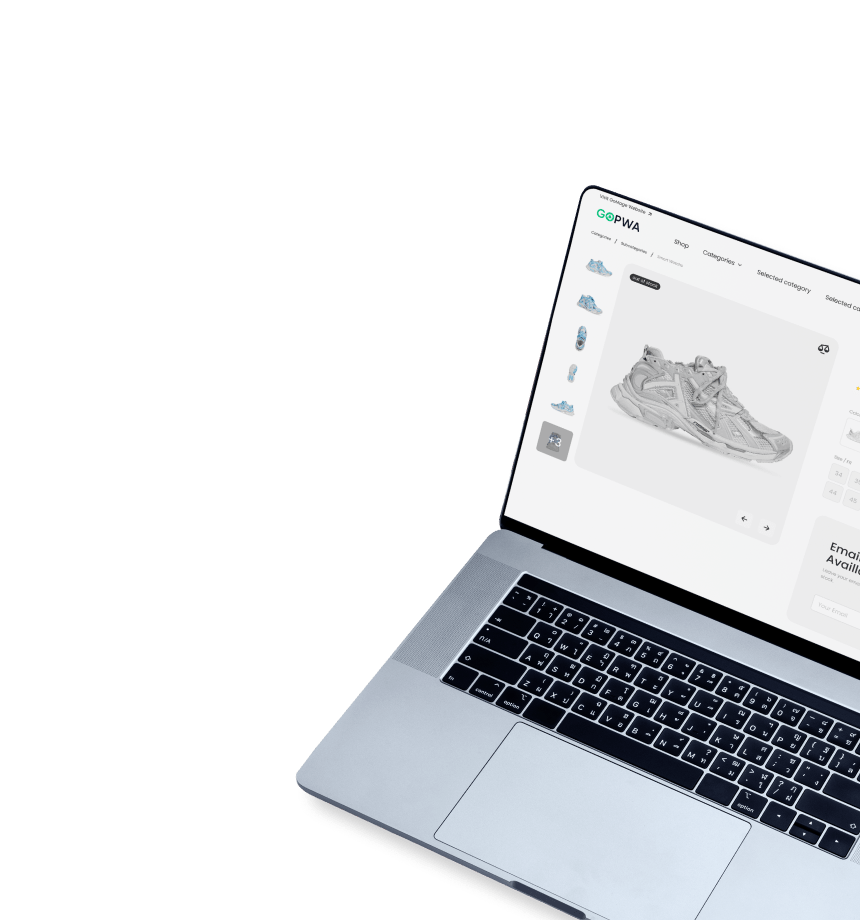
What are the Challenges of Headless Commerce?
While headless B2B eCommerce offers a myriad of benefits, it’s not without its challenges. Understanding these obstacles can help you prepare for them and develop solutions that ensure your headless commerce journey is a success. Here are some common challenges you might encounter:
-
- Technical Complexity: Headless commerce inherently requires a higher degree of technical expertise. Managing APIs, integrating systems, and customizing front-end experiences require a capable development team. If your team lacks experience in these areas, you may need to invest in training or consider partnering with an external agency for setting up a headless platform.
- Resource Intensive: Building and customizing your front-end can be resource-intensive, both in terms of time and cost. Depending on the level of customization you require, you might need to allocate substantial resources to create the desired customer experiences on your eCommerce system.
- Maintenance: With monolithic systems, updates and maintenance are often handled by the platform provider. With a headless setup, however, responsibility for maintaining both the front-end and back-end falls to your team. This can increase the workload for your IT team.
- Integration Challenges: Ensuring seamless integrations between your front-end and various back-end systems can be complex. Any hiccups can lead to data discrepancies, operational inefficiencies, and a poor customer experience.
- SEO Considerations: With the freedom of front-end customization, it’s essential to remember the importance of SEO. Custom elements and dynamic content can sometimes lead to SEO issues, so it’s crucial to maintain SEO best practices during development.
- Potential for Increased Complexity: A headless architecture can add complexity to your operations, with more elements to manage separately. It’s crucial to have robust project management in place to handle this increased complexity.
Understanding these challenges is the first step towards overcoming them. In our next and final chapter, we will provide solutions to these challenges and offer tips on how to make your transition to headless commerce smooth and successful.
Navigating the Challenges of B2B Headless Commerce
The challenges of transitioning to a headless commerce platform may seem daunting, but they can be successfully navigated with strategic planning, the right resources, and a thorough understanding of the process. Here’s how you can tackle these challenges:
- Building a Skilled Team: Having a technically proficient team is crucial for the success of your headless commerce transition. Invest in training your team, or consider partnering with skilled eCommerce companies. Remember, having the right people with the right skills can make the transition significantly smoother.
- Effective Resource Management: Planning and allocating resources effectively can help manage the increased demands of a headless commerce setup. Consider the time, cost, and manpower required for each stage of the implementation and plan accordingly.
- Regular Maintenance and Updates: Create a robust maintenance and update schedule to keep your platform running smoothly. Regular updates will not only keep your platform secure but also ensure that you’re providing the best possible experience for your customers.
- Robust Integration Plan: Developing a clear and comprehensive integration plan can help you avoid integration hiccups. This plan should detail how each system will be connected, data flow paths, and contingencies for potential issues.
- SEO Best Practices: Ensure your development team is well-versed in SEO best practices. Regular audits and adjustments can help maintain your site’s visibility and ranking, even as you introduce new and dynamic content.
- Project Management: Adopt strong project management practices to handle the increased complexity of a headless commerce setup. This could involve employing project management software, hiring a project manager, or refining your existing project management processes.
Facing these challenges head-on can result in a seamless transition to a headless commerce platform and set your business up for long-term success. Remember that the journey to headless commerce is not just a shift in technology; it’s a strategic approach to adapt to an ever-evolving digital world. It’s about future-proofing your business and equipping it with the ability to provide exceptional experiences that meet and exceed your customers’ expectations.
Unleashing the Future of B2B eCommerce with GOPWA
As eCommerce is revolutionizing at a breakneck speed, staying competitive necessitates adopting cutting-edge technologies that promise engaging experiences and heightened conversions. One such innovation is the Progressive Web Application (PWA), and leading this transition is GOPWA – an all-encompassing solution that transforms the eCommerce landscape.
A Single PWA for a Raid Expansion
Progressive Web Apps (PWAs) offer a myriad of benefits that cater to the rapid expansion of businesses. They provide an app-like experience right on the browser, eliminating the need for users to download anything, thus saving valuable space on their devices. They also ensure lightning-fast loading times, even in conditions of poor internet connectivity, which enhances user experience.
Additionally, PWAs are device-agnostic, meaning they provide a consistent user experience across all devices, be it a desktop, a tablet, or a mobile phone. Their ability to send push notifications increases engagement, while offline functionality keeps users engaged even when they lose internet connectivity. Furthermore, they are highly cost-effective as they can be developed, maintained, and updated at a fraction of the cost of traditional mobile apps. You don’t have to create an eCommerce application for iOS and Android, as you can build a single PWA that will work across all platforms.
A New Paradigm with GOPWA
GOWA leverages the power of PWAs, offering a superior storefront that fast-tracks your eCommerce store to top scores on PageSpeed Insights. By providing near-instant page loads, it guarantees an ultra-smooth shopping experience, thereby enhancing customer satisfaction and boosting conversion rates.
Features that Speak Volumes
But speed is just the tip of the iceberg. GOPWA encapsulates an entire spectrum of essential features. With its dynamic content editor, you can effortlessly tailor your website, including category pages, product pages, and the checkout process. Plus, it brings premium UI features such as product comparison, multi-wishlist, zoom-in on product images, quick buy options, social sharing, and a built-in Instagram feed to the table, offering a comprehensive and immersive user interface experience.
Furthermore, GOPWA puts a strong emphasis on enhancing user experience by incorporating advanced search features like autocomplete, recommendations, popular search terms, and search history tracking. It’s also armed with robust selling and tracking tools that help monitor online purchases performance effectively.
Mastering Mobile Commerce
GOPWA understands the essence of mobile commerce. Offering an app-like interface with lightning-fast loading times, push notifications, an ‘add-to-home’ screen feature, offline mode, and device agnosticism, it ensures a delightful shopping experience across all browsers and devices. This mobile-first approach is a sure-fire way to elevate conversions and enhance user engagement.
Seamless Transition with GoPWA
Transitioning from a traditional Magento setup to a headless online store with GOPWA isn’t just cost and time-effective but also resolves performance issues. Compared to traditional online stores, GOPWA offers lightning-fast page loads, supports a single design for all screens, allows unlimited frontend customizations, and provides compatibility with every device.
Trust and Affordability
Renowned brands trust GOPWA, demonstrating its capacity to manage high-traffic, enterprise-scale eCommerce operations. The technology has helped businesses witness significant increases in conversions, re-engagement rates, checkout conversions, and notable reductions in bounce rates.
For a nominal starting cost, GOPWA saves you hundreds of development hours that would have been spent building a PWA from scratch. It offers a package of 45 PWA features and extensions out-of-the-box, making it a cost-effective choice for businesses eager to stay competitive.
GOPWA stands as a testament to the future of B2B eCommerce, offering a comprehensive solution that combines superior performance, extensive customization options, and user-friendly features. It has proven its worth by significantly boosting conversions and fostering customer loyalty, positioning itself as an indispensable tool for any business seeking to succeed in the dynamic landscape of eCommerce.
With GOPWA, you’re not just investing in a platform – you’re embracing a technology that can redefine your eCommerce business. So gear up and ride the wave of the future with GOPWA. The era of headless eCommerce is here.
Headless B2B Commerce: Key Takeaways
The transformative power of headless commerce is reshaping the B2B landscape, offering unparalleled flexibility, enhanced user experience, and a direct path to increased conversions.
- Flexibility: In headless B2B commerce, the front-end and back-end are decoupled. This provides businesses with the freedom to adapt and scale their front-end without disrupting the core business operations managed by the back-end.
- Personalized Experiences: Headless commerce enables you to offer personalized, consistent experiences across all customer touchpoints. This can result in higher customer satisfaction and, ultimately, more conversions.
- Speed and Performance: Headless commerce promises faster page loads and smoother site performance, enhancing the overall user experience and driving conversion rates.
- Future-proof: A headless system is more adaptable to technological shifts and advancements, ensuring your eCommerce platform stays relevant and competitive.
- GOPWA: Leveraging the power of PWA technology, GOPWA offers a robust, high-speed storefront with extensive customization options. Transitioning to G)PWA could lead to significant cost and time savings, without supercharged website performance.
Are you ready to embrace the future of headlessB2B eCommerce and unlock new potentials for your business? Contact us for a consultation and let’s journey towards success together with headless commerce. Your success story starts here.


